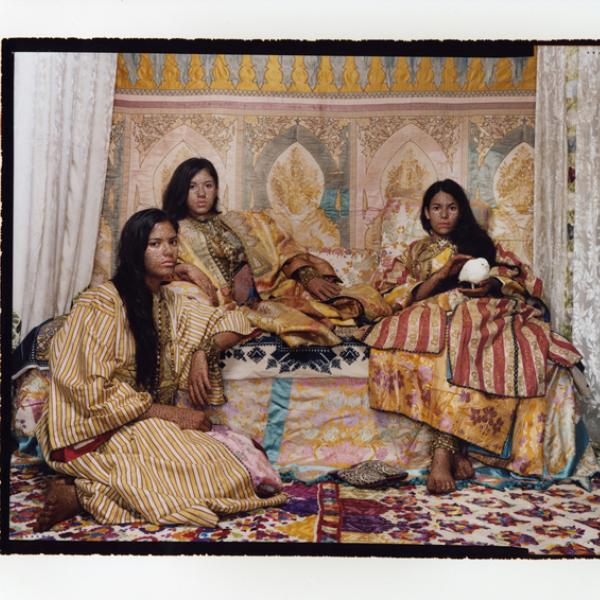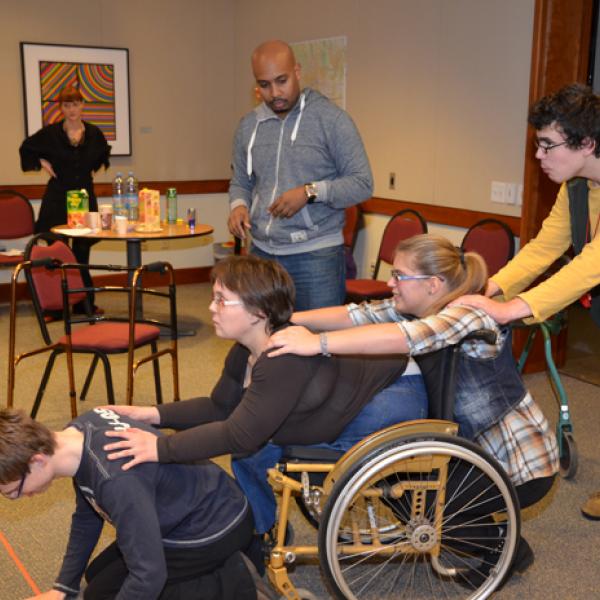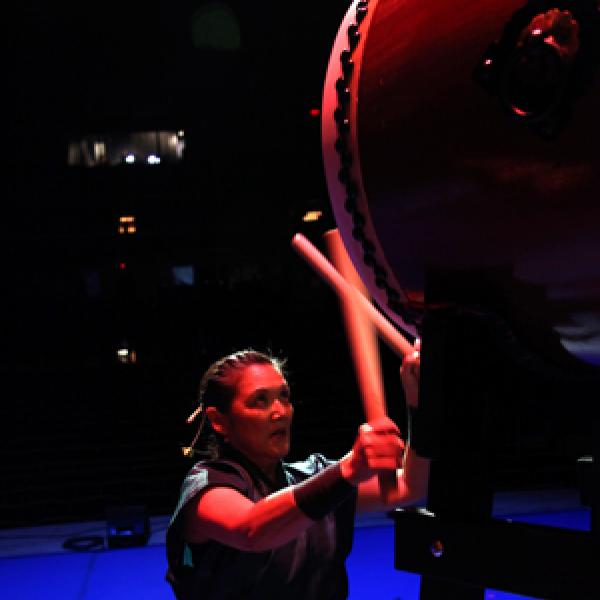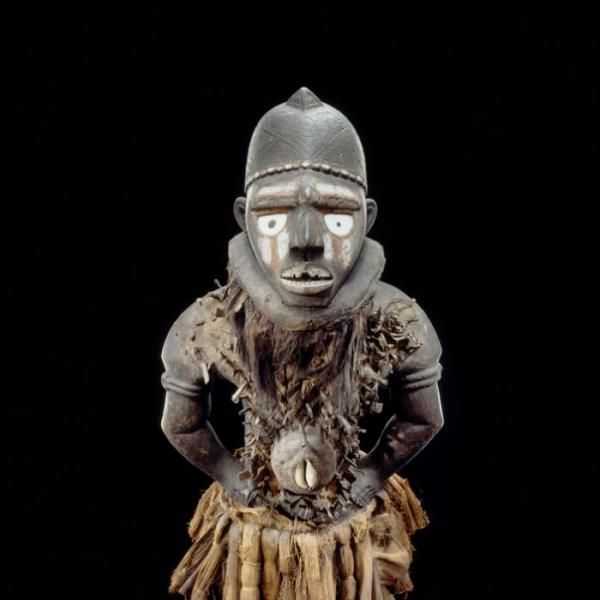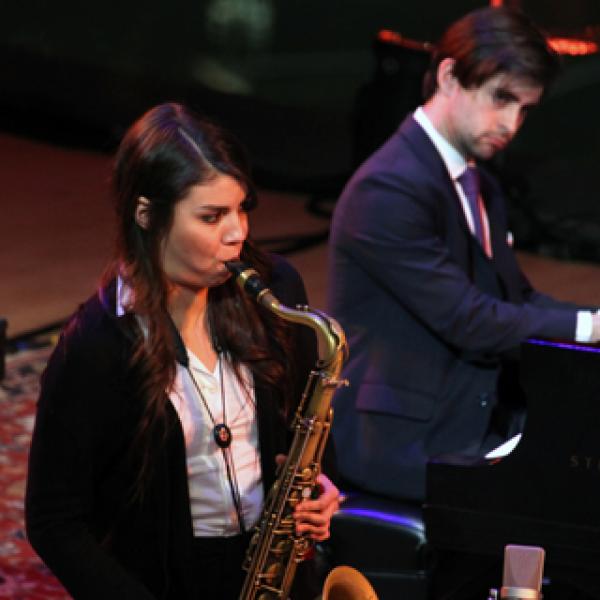A New Rhythm
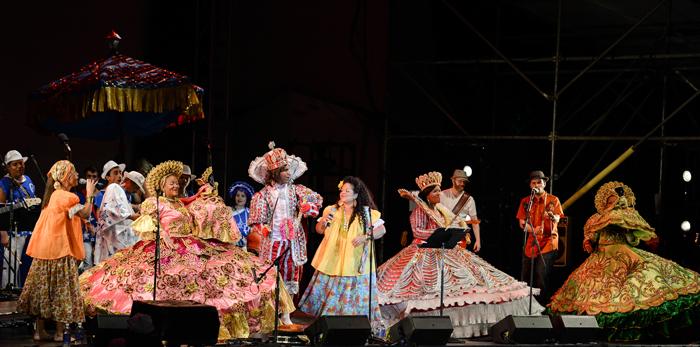
Brazilian maracatu? So what is this? A rare bird? Exotic fruit? Tropical plant? While Brazilian samba is a popular musical form listened and danced to in living rooms and clubs across the U.S., few of us have heard the charged, driving, percussive rhythms called maracatu, which hails from northeastern Brazil.
For those of us without a Brazilian connection, there was little chance to encounter the form, let alone witness it live. That is, until the summer of 2013 when audiences in seven cities across the U.S. rejoiced with the music and dancing of Maracatu Nação Estrela Brilhante.
Founded in 1906, Estrela Brilhante is one of the oldest and most renowned and respected maracatu groups in Brazil and internationally. Led by the legendary Mestre Walter Ferreira de França and Queen Dona Marivalda Maria dos Santos, Estrela Brilhante performs mainly in the streets rather than on stages, with the public mingling freely among and participating joyfully with the musicians and dancers. Their 1996 album Amazônica was the first recording of maracatu music, and the group has toured widely in Brazil and abroad to Germany, Portugal, France, and the Netherlands. Until their 2013 engagements however, they had never performed in the U.S.
The grant program Southern Exposure: Performing Arts of Latin America was key to making Estrela Brilhante’s tour possible. A partnership of the NEA, Mid Atlantic Arts Foundation (MAAF), and the Robert Sterling Clark Foundation, Southern Exposure funds consortia of U.S. arts organizations to present exemplary contemporary and traditional dance, music, and theater companies from Latin America to perform and engage with communities across the United States.
As is common for international projects, the Estrela Brilhante U.S. tour had a long incubation period. The roots for this particular project date back to 2001, when Brooklyn-based percussionist and bandleader Scott Kettner spent a year in Brazil learning and living maracatu music. His recently published book, Maracatu for Drum Set and Percussion, explains that maracatu is much more than a rhythm; it is a lifestyle in which the practitioners, even in the 21st century, are steeped in the tradition of their forefathers. The musical form goes back to the colonial period in Brazil when African slaves copied (and mocked) the pageantry of the Portuguese monarchy by creating their own court of elaborately costumed royals, complete with a king and queen attended by princes and princesses. Catholicism and tribal ritual converged into new deities that became part of the pageantry that is celebrated in maracatu.
As part of the Southern Exposure grant, Kettner worked with Lincoln Center to create a tour billed as A Tale of Two Nations, which featured Maracatu Nação Estrela Brilhante along with Nation Beat, Kettner’s own U.S.-Brazilian music collective. The joint performing ensemble involved 13 Brazilian Estrela Brilhante musicians and dancers and five Nation Beat musicians and vocalists. Whereas in Brazil, maracatu groups range in size from 30 or 40 and incorporate 100 or more drummers and dancers, this collaborative format allowed the visiting maracatu artists to perform in their powerful and dynamic traditional style, complete with the pageantry and procession, using an ensemble of a size that was financially feasible for a range of U.S. presenters.
A Tale of Two Nations premiered as part of New York’s Lincoln Center Out of Doors Festival on August 2, 2013, marking Maracatu Naçao Estrela Brilhante’s U.S. performance debut. Maestre Walter led the musicians of Estrela Brilhante and Nation Beat, while Queen Marivalda and her court danced under a royal canopy in their richly brocaded hoop skirts and elaborate headdresses. A diverse and appreciative crowd of 4,000 sang and danced along with the performers in an atmosphere of unbridled energy.
The members of Estrela Brilhante were overcome with emotion. One of the group’s drummers, Marcelo Tompson, who acted as spokesperson, remarked, “Even in Brazil, I don’t think we have ever performed before so many people. It was simply maravilhoso!”
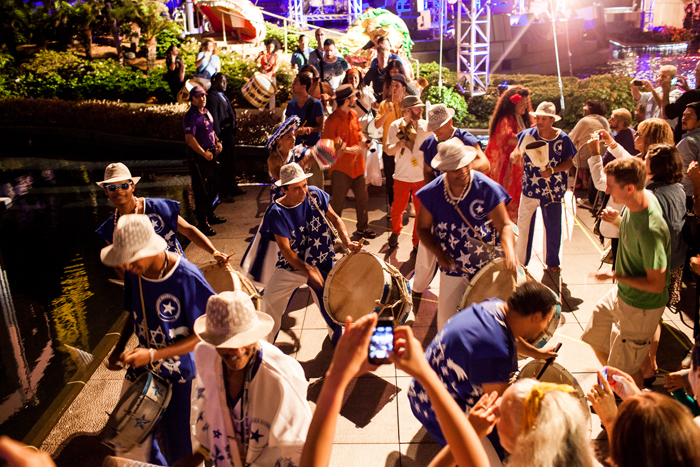
A few weeks later, Estrela Brilhante was off to Los Angeles, where they performed as part of the Grand Performances free concert program. Well before the group’s arrival however, executive director Michael Alexander and his staff at Grand Performances laid the groundwork to build community interest in maracatu. In May, Kettner visited L.A. and led workshops for more than 40 professional and pre-professional drummers. To ensure local musicians could experience the true sound of the traditional instruments, Grand Performances identified a Brazilian drum maker based in San Diego and rented authentic maracatu drums for participants, most of whom had never seen these particular drums, the alfaias.
When Estrela Brilhante arrived, they offered a follow-up workshop for drummers and one for dancers, sharing some of their own drums, bells, and costumes. Nearly 200 people participated in the various workshops. The final performance took place in August just before Estrela Brilhante’s return to Brazil, drawing more than 2,000 people and including local workshop participants in the vibrant procession that moved from stage to street.
At all of their performance sites, the members of Maracatu Nação Estrela Brilhante offered workshops and demonstrations to local artists and community members. Perhaps the most compelling outreach experience occurred at Silvermine Arts Center in New Canaan, Connecticut. Months prior to the event, Silvermine staff created a short video about maracatu, and working with the Norwalk Housing Authority, used it to recruit teens living in subsidized housing to participate in a carnival costume design workshop.
Over a two-month period, a Silvermine faculty member held classes with middle and high school students to design and sew costumes. Once Estrela Brilhante arrived, Queen Marivalda and her princesses worked intensely with the students. On the night before the event, the Queen and her costume crew played the role of fairy godmothers and did some final work to surprise the students. The next day, students found the costumes done up in full pageantry style, with matching tops and headdresses to wear with their decorated skirts. Expecting only to be part of the procession, the students were thrilled to be included in the full performance.
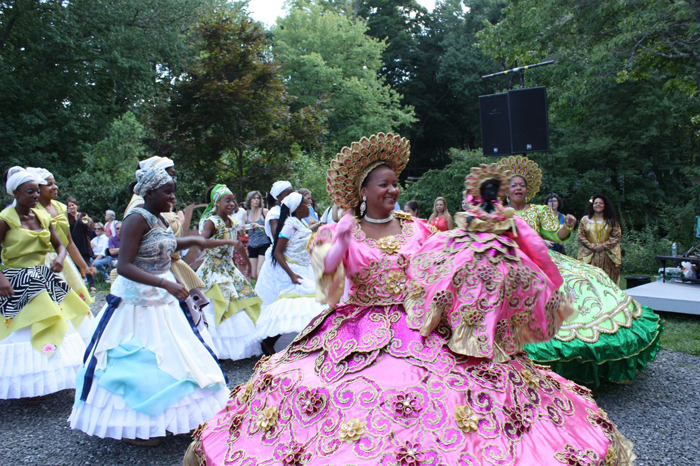
“The engagement with Maracatu Nação Estrela Brilhante and the Tale of Two Nations had a much-deeper and longer-lasting impact on us and our community partners than we ever could have anticipated,” said Leslee Asch, executive director of Silvermine. She observed that interacting with the performing group’s strong and disciplined women was inspirational for the students. Speaking of the Norwalk youth, Tompson of Estrela Brilante added, “At the performance, joy was stamped on their faces.”
Granted, maracatu has yet to become a household word. Yet, through the month-long inaugural U.S. tour of Maracatu Nação Estrela Brilhante, thousands of Americans across the country had a personal introduction to the music and its cultural context. The visiting Brazilian artists left with feelings of enormous pride and a full heart. As noted by Tompson: “Opening a space [in the U.S. music scene] for maracatu, which until not long ago was overlooked even in Brazil, is priceless.”
Pennie Ojeda is the former director of the NEA’s international programs.



